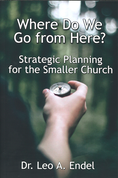 When change is needed, a pastor has to be a better leader than leaders in most other segments of our culture for two reasons. In other sectors, a leader can, at the minimum, get people to accept the change because if they don’t the paychecks stop coming. On the other hand, a pastor is expected to motivate, equip, and deploy volunteers who can choose to walk away when they don’t like the change. Secondly, we live in a rapidly changing world in which COVID has forced even more changes. Everyone’s tolerance for change has been tested! What also makes leading change in the church harder is that most committed believers view their church as a haven of rest, a place of stability and security from a world rocked by chaos and change. So when changes are needed, and in today’s world every church has had to make significant changes, a pastor has to be able to clearly define current reality, communicate why change is needed, know how to identify what the right changes are, and be able to lead the adoption and implementation of those changes. From my experience, and I have had it confirmed by others who serve churches in a similar capacity, the majority of pastors use their gifts of shepherding, teaching, and preaching more than they do their gift of leadership. That reality shouldn’t surprise us when we stop and remember the majority of churches are single staff or bi-vocational, and the day-to-day pastoral care required is extremely fluid. Most churches end up reacting to the changes that are forced upon them rather than being proactive to identify needed change and implement it well. Because of the changes that engulf us, the need for thoughtful and prayerful leadership is greater today than it has been in decades. The early church had to navigate significant change. Acts 1:15-26 records a simple four-step process describing how the church replaced Judas as an apostle. First, they established specific criteria (21-22). Second, they identified their top two candidates (23). Third, they had a time of focused prayer (24-25). Finally, they used a culturally accepted selection process (26). We see a similar process used in Acts 6:1-7 when the church made major changes to their ministry to widows. First, they defined their new reality—the church was growing, there were unmet needs, and the current leadership structure was not adequate (1-2). Then they defined the criteria for the new ministry role and clarified the ongoing role of the apostles (3-4). They received consensus from the church (5a). Fourth, they identified men who met the criteria (5b-6a). They had a season of prayer to seek God’s face (6b). Finally, there was a formal recognition of those selected through the laying on of hands (6c). Processes are available, but how can a pastor and church in a chaotic and busy 2020 world find time to define reality, identify what needs to change, brainstorm options, determine the best choices, and implement the needed change? Well, I’m delighted to share with you a resource I encountered a few weeks ago. It is the book Where Do We Go from Here? Strategic Planning for the Smaller Church by Dr. Leo A. Endel. I even used it Saturday with one of our language churches. Dr. Endel is a long-time friend, and the book lays out a simple process that with minimal coaching any pastor could use to lead a one-day strategy training event. Heartland Church Network has purchased several copies, and if you are interested, I would love to get you a copy. I am also willing to coach you as you use it in your church. Give me a call, send me a text, or drop me an e-mail and I will get you a copy. After you’ve read it, give me a call, and we can talk through the process. Take time to lead in a prayerful and proactive manner without having to use a painfully long and often unproductive process. Yours in Christ, Mark R. Elliott, DoM
0 Comments
Leave a Reply. |
AuthorRetired in April 2022, Mark R. Elliott served as a Director of Missions (Associational Mission Strategist) in Western Iowa and Eastern Nebraska for almost three decades. He is a strong advocate for obedience and Biblically based disciple making. As such, he knows that making healthy disciples requires Christian leaders to be constantly pursuing spiritual maturity—be lifelong learners. Because of the time constraints of ministry, most pastors focus their reading list on resources that assist them in teaching and preaching the Word of God. As such, books focusing on church health, leadership development, and church growth tend to find their way to the bottom of the stack. With that reality in mind, Mark has written discussion summaries on several books that have helped him to personally grow in Christ and that tend to find themselves on the bottom of most pastor’s stack. Many pastors have found them helpful as they are able to more quickly process great insights from other pastors and authors. Archives
April 2022
Categories |
Looking for something? |
© COPYRIGHT 2024. ALL RIGHTS RESERVED.
|




 RSS Feed
RSS Feed
